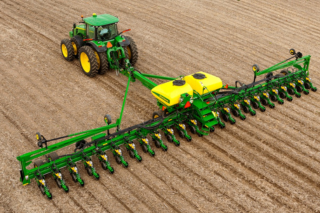Planting Do's & Don'ts
Apr 21, 2025

It’s finally starting to feel like spring and tractors are hitting the fields. It can get easy to get caught up in the excitement of season, but it’s crucial to keep in mind key factors that are going to set your fields up for success.
DO wait for the ideal soil temperature. I use the Department of Agriculture website as a resource. As of Sunday, April 20th, Paynesville has an average soil temperature of 45, Westport has a temperature closer to 35. Why does this matter? Corn prefers to germinate at 50. Soybeans tend to prefer even warmer. Seed that sits too long in cold soils will have less than ideal germination and uneven emergence. A study done by Iowa State University concluded that corn planted in 50-degree soil temperatures took 3 weeks to germinate and emerge; corn planted in 60-degree soil temperatures took 10-12 days.
DO NOT rely on cold germ tests. These are NOT federally required and the least replicated germination tests, meaning there is no standardized way of performing them and each lab will have a different process of testing seed.
DO double check that your planting population is correct. Most varieties have a response to population; depending on the soil type, some varieties do much better with lower populations, while others thrive with higher rate. Your agronomist can help you decide on a population for your hybrid and farm.
DO NOT mud any seed in, if possible. Cold soils aren’t ideal for germination, but cold, saturated soils are infinitely worse. While some varieties can handle wet feet, there isn’t one that genuinely thrives in it. Saturated soils have an increased risk of seed rot and fungal diseases and will have a negative impact on yield.
DO remember that your seed has the most potential inside the bag. It is up to you to protect that investment and potential. Use a seed treatment, use in-furrow insecticide, double check your planting depth and population. A liquid starter fertilizer, like Upshift with Ultra-che Zinc and Ascend, can help support even emergence across your corn fields.
DO NOT forget best-management practices, even if it feels like the season is getting late. It’s not worth getting sloppy with planting if waiting a week would have a better outcome. Please call your agronomist if you feel yourself on the Cliff of Panic; we will try to help ease your stress with any solutions we can come up with.
DO stay safe this planting season! Nothing is worth rushing when safety is not taking priority.
DO wait for the ideal soil temperature. I use the Department of Agriculture website as a resource. As of Sunday, April 20th, Paynesville has an average soil temperature of 45, Westport has a temperature closer to 35. Why does this matter? Corn prefers to germinate at 50. Soybeans tend to prefer even warmer. Seed that sits too long in cold soils will have less than ideal germination and uneven emergence. A study done by Iowa State University concluded that corn planted in 50-degree soil temperatures took 3 weeks to germinate and emerge; corn planted in 60-degree soil temperatures took 10-12 days.
DO NOT rely on cold germ tests. These are NOT federally required and the least replicated germination tests, meaning there is no standardized way of performing them and each lab will have a different process of testing seed.
DO double check that your planting population is correct. Most varieties have a response to population; depending on the soil type, some varieties do much better with lower populations, while others thrive with higher rate. Your agronomist can help you decide on a population for your hybrid and farm.
DO NOT mud any seed in, if possible. Cold soils aren’t ideal for germination, but cold, saturated soils are infinitely worse. While some varieties can handle wet feet, there isn’t one that genuinely thrives in it. Saturated soils have an increased risk of seed rot and fungal diseases and will have a negative impact on yield.
DO remember that your seed has the most potential inside the bag. It is up to you to protect that investment and potential. Use a seed treatment, use in-furrow insecticide, double check your planting depth and population. A liquid starter fertilizer, like Upshift with Ultra-che Zinc and Ascend, can help support even emergence across your corn fields.
DO NOT forget best-management practices, even if it feels like the season is getting late. It’s not worth getting sloppy with planting if waiting a week would have a better outcome. Please call your agronomist if you feel yourself on the Cliff of Panic; we will try to help ease your stress with any solutions we can come up with.
DO stay safe this planting season! Nothing is worth rushing when safety is not taking priority.